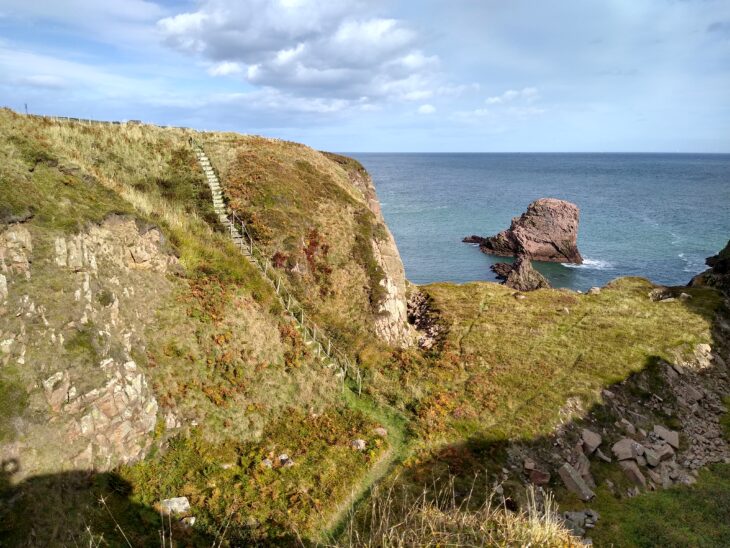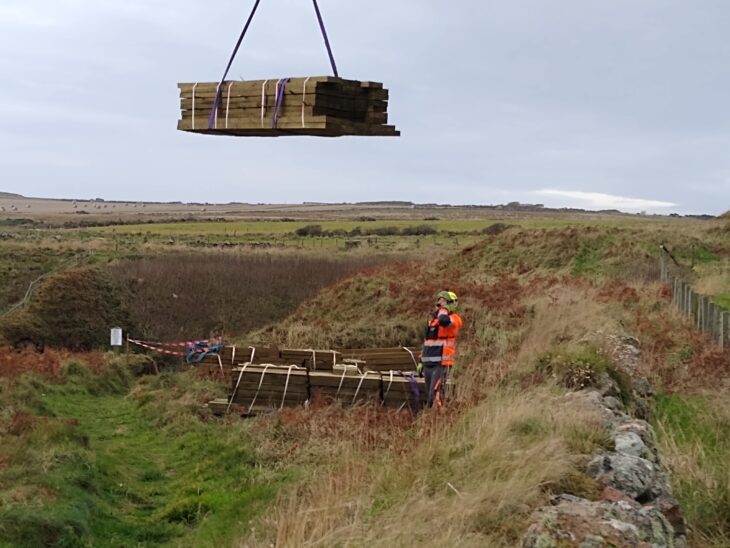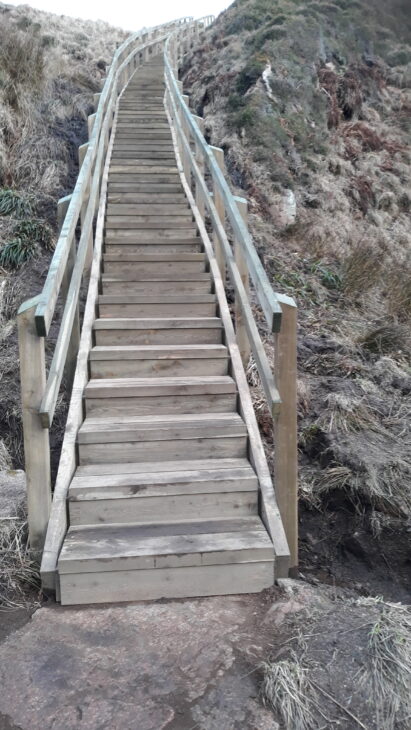Installing new steps at Heathery Haven on Longhaven Cliffs Wildlife Reserve

Rab Potter, Reserves Manager shares the technical details of installing a new flight of steps on our Longhaven Cliffs Wildlife Reserve in Aberdeenshire which had a steep gradient. These access improvements were made possible by a £25,000 grant from Aberdeenshire Council’s Coastal Communities Challenge Fund. Read the news story here.
During November 2022 work started on the site by removing the old steps and bagging up the old timber to be airlifted out. Preparatory work was done to even out the ground along the line of the path and dig out the drainage ditches. A large flat topped stone was dug in at the bottom of the flight of steps to prevent walkers treading down onto soft ground at the bottom.

Work on the new steps began once the new timber was airlifted in.

A uniform structure from bottom to top had been designed. This consisted of a series of 3 metre long stringers (3000 x 200 X 60mm) fixed to 90mm square posts every 1.5 metres on both sides of the path. To make each step, a pair of blocks (100 x 130 x 320mm) were fixed to the stringers ensuring that they were level and equal height. Each step was made up of two treads (900 X 180 x 60mm) and screwed on to the blocks. Risers were screwed onto the front of the blocks allowing the front tread to have a small overhang.

Due to the very steep gradient of the slope and no practical way of taking a less steep line, the gradient was kept as even as possible to prevent any part of it being even steeper. This was around 25 degrees, reducing to nearer 20 degrees at the top. (The previous steps were over 35 degrees in places and very awkward to walk up or down). To help keep the gradient even, some of the path line needed to be dug out (for about ten metres below the half way point and the top six metres) while for about eight metres above the half way point the path needed to be raised on the outside edge. To strengthen the raised section, double posts were used instead of single.

A petrol driven post driver was used to drive in the posts. The ground proved to be extremely variable with some posts driving in over two meters before refusal. Longer posts had to be bought and carried onto site. Stones within the mud were common and frequently the posts tried to twist or lean when being driven in. It was important for the square posts to be vertical, with the flat side flat against the stringer. The posts needed positioning accurately to ensure the stringers were the right distance apart for the treads and risers to fit. Several of the posts needed a wooden spacer to reduce the width between the stringers.

Self tapping coach screws were used to secure the stringers to the posts and the blocks to the stringers. Wafer head screws were used to fix the treads to the blocks while the risers were secured to the blocks using counter sunk phillips head screws. No nails were used in its construction. Wherever the timber was cut (such as the post tops sawn to handrail height) the exposed wood was painted with an end grain preservative.
This project was supported by NESFLAG and funded by Aberdeenshire Council’s Coastal Communities Challenge Fund.

Help protect Scotland’s wildlife
Our work to save Scotland’s wildlife is made possible thanks to the generosity of our members and supporters.
Join today from just £3 a month to help protect the species you love.
Preface
Rab Potter, Reserves Manager shares the technical details of installing a new flight of steps on our Longhaven Cliffs Wildlife Reserve in Aberdeenshire which had a steep gradient. These access …
